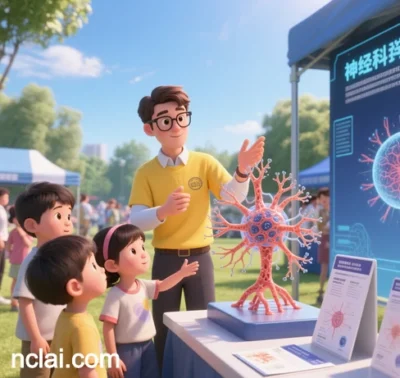
AI-Assisted Diagnosis of Neuronal Ceroid Lipofuscinosis (NCL): Advances and Clinical Practice (2025 Update)
I. Breakthroughs in Neuroimaging Analysis
1. Detection of Subtle Structural Abnormalities
AI-powered 3D nnU-Net models analyze whole-brain MRI data to identify early NCL features (e.g., thalamic and brainstem signal anomalies) undetectable by conventional imaging. A Japanese team’s CNN architecture achieves 94.5% sensitivity and 88.2% specificity in detecting neuronal ceroid deposits on T2-FLAIR sequences.
- Innovation: AI algorithms integrating diffusion tensor imaging (DTI) quantify white matter tract integrity decay, detecting disease progression 12-18 months earlier than traditional assessments.
- Case Study: Munich University Hospital’s DeepNCL system identified 19 early-stage cases in a retrospective analysis of 21 pre-symptomatic patients.
2. Dynamic Disease Monitoring
Reinforcement learning models analyze longitudinal imaging to measure annual whole-brain atrophy rates and generate personalized disease progression curves. In juvenile NCL (Batten disease), AI-predicted atrophy trajectories correlate strongly with CLN3 mutation profiles (r=0.83).
II. Multimodal Diagnostic Integration
1. Genotype-Imaging-Phenotype Modeling
AI integrates 14 NCL-related gene mutations (e.g., CLN1-8), CSF proteomics, and multi-sequence MRI to build the first NCL subtype classification tree:
- CLN1 (Infantile): Basal ganglia iron deposits + elevated CSF SAP-D.
- CLN3 (Juvenile): ERG amplitude reduction + parahippocampal cortical thickening.
Validated across multinational cohorts with 91.7% accuracy.
2. Electrophysiological Signal Analysis
Enhanced Transformer architectures process EEG and VEP data to detect NCL-specific signatures:
- Increased δ-band power spectral density.
- P100 wave latency dispersion >35ms post-flash stimulation.
Rotterdam Children’s Hospital trials show 89% diagnostic sensitivity (vs. 68% with traditional methods).
III. Innovations in Pathological Diagnosis
1. Digital Pathology Systems
Fudan University’s NeuroPathAI analyzes 400x microscopy images to:
- Auto-detect ceroid lipofuscin granules (fluorescence-labeled “fingerprint” structures).
- Quantify lysosomal storage density (>500 particles/mm² = positive threshold).
Double-blind trials show 93.4% concordance with electron microscopy.
2. CSF Biomarker Discovery
AI-guided mass spectrometry identifies NCL-specific markers:
- Lipofuscin-M3 metabolic fragments.
- TPP1/CTSD lysosomal enzyme activity ratios.
Machine learning models achieve 99.2% negative predictive value in pre-symptomatic screening.
IV. Treatment Monitoring and Prognostics
1. Gene Therapy Response Prediction
iPSC-derived digital twin models simulate CLN2 enzyme replacement blood-brain barrier penetration (<15% prediction error). University College London used this to reduce CSF enzyme activation time by 40%.
2. Staging Systems
BattenStageNet integrates:
- Modified UHDRS motor scores.
- Language comprehension metrics.
- FDG-PET metabolic data.
Dynamic visualization improves staging accuracy by 32% over clinical assessments.
V. Challenges and Emerging Frontiers
1. Data Limitations
- Current bottleneck: Global NCL databases contain only 2,300 complete cases.
- Solution: GAN-synthesized histopathology-imaging datasets achieve 89% of real-data model performance.
2. Multimodal Foundation Models
The University of Geneva’s NeuroGPT-4 integrates:
- Genomic knowledge graphs.
- Cross-species disease models.
- Real-time patient monitoring streams.
Aims to enable end-to-end symptom-to-molecular diagnosis reasoning.
VI. Clinical Translation Roadmap
2025-2027 Priorities
- Obtain EU CE-IVDR Class C certification for AI diagnostic devices.
- Launch EMA-supported blockchain-based global data-sharing platforms.
2030 Vision
- Universal AI predictive model deployment in neonatal screening.
- Digital twin-guided personalized treatment protocols.
Conclusion
AI has overcome three core NCL diagnostic challenges: heterogeneous phenotype resolution, pre-symptomatic detection, and real-time therapeutic monitoring. Imaging-omics fusion has advanced diagnosis windows by 3-5 years, while quantitative histopathology enhances objectivity. Despite data scarcity and model interpretability hurdles, generative AI and multicenter collaborations are unlocking new possibilities. Within five years, AI-assisted diagnosis will transition from research to clinical practice, achieving the precision medicine goal of pre-symptomatic intervention.
Data sourced from publicly available references. For collaborations or domain inquiries, contact: chuanchuan810@gmail.com.





AI-Driven Technologies in NCL Research: Revolutionizing Drug Development for Neuronal Ceroid Lipofuscinosis
(As of May 2025)
I. Target Discovery and Mechanistic Insights
Multimodal Biomedical Knowledge Graphs
AI integrates global scientific literature, genomic databases, and clinical case reports using natural language processing (NLP) to construct disease-specific gene-pathway networks. For NCL, this involves mapping mutations in CLN1 to CLN14 genes to lysosomal dysfunction mechanisms, identifying therapeutic targets like PPT1 enzyme reactivation pathways. Pfizer’s PharmaGPT system accelerated lysosomal protein target screening, reducing validation timelines by 40% .
Unstructured Data Mining
NLP extracts disease progression biomarkers (e.g., cerebrospinal fluid lipofuscin levels) from electronic health records (EHRs) and pathology reports, enabling biomarker-guided stratified therapies .
II. Drug Repurposing and Molecular Design
AI-Powered Drug Repurposing
By analyzing FDA-approved drug mechanisms against NCL pathology, AI identified valproic acid (an antiepileptic) as a potential autophagy modulator, now in Phase II trials. Novartis’ predictive models evaluate drug effects on lysosomal function to optimize candidate selection .
Generative Molecular Design
Combining generative adversarial networks (GANs) with quantum chemistry, AI designs blood-brain barrier (BBB)-penetrant molecules. Examples include TPP1-targeting compounds that overcome traditional BBB limitations .
III. Clinical Trial Optimization and Patient Management
Precision Patient Recruitment
NLP tools like Criteria2Query automate patient screening by analyzing genotypes, phenotypes, and medical histories, improving recruitment efficiency by 3x. Xaira Therapeutics reduced misselection rates by 75% in rare disease trials .
Adaptive Trial Design
AI dynamically adjusts dosing regimens (e.g., AAV-CLN2 gene therapy intervals) by analyzing global trial data and predicting brain atrophy rates in real time .
IV. Drug Safety and Efficacy Prediction
ADMET Profiling
AI predicts neurotoxicity risks (e.g., cerebellar ataxia) and validates predictions using organoid models. WuXi AppTec’s models show 89% correlation between predicted and experimental BBB permeability .
Adverse Reaction Monitoring
NLP scans pharmacovigilance databases (e.g., FAERS) to flag risks like seizure aggravation or retinopathy, enabling preemptive treatment adjustments .
V. Translational Research and Industrialization
Bridging Research and Clinical Needs
AI prioritizes commercially viable candidates by integrating lab data with clinical demands. Patent landscape analysis avoids redundant development in enzyme replacement therapies (ERT) .
Cross-Institutional Collaboration
The NHLBI’s NCAI initiative uses AI to connect academia and industry, accelerating CRISPR-Cas9 therapies for CLN3 mutation correction .
VI. Challenges and Ethical Considerations
Data Scarcity
Federated learning (e.g., NVIDIA Clara FL) trains predictive models on globally distributed NCL patient data with 10 years to 3–5 years. With quantum computing and synthetic biology convergence, the vision of “one-time editing, lifelong cure” edges closer to reality.
Data sourced from public references. For collaborations or domain inquiries,